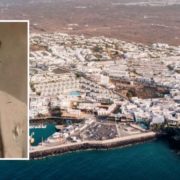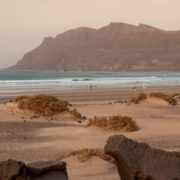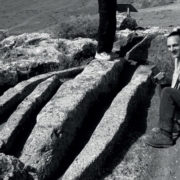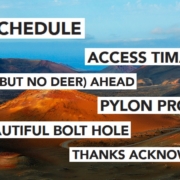Rafael Cabrera Padrón is the man who prepared the ground for Puerto del Carmen’s transformation into Lanzarote’s most important tourist resort.
A hundred years ago, Puerto del Carmen did not exist. Instead, there was the small fishing village of La Tiñosa, home to fewer than 400 people.
The men were fishermen, known for their skill in handling boats, while the women were mainly devoted to drying and preserving the fish they caught. The good times of the barrilla (lime ash) industry had long gone, the tomato exporting industry had not yet begun and times were tough, with widespread poverty. In the late 1920s, the local priest wrote that “the residents of La Tiñosa are terrible Christians – they donate nothing to raise the walls (of the church).”
But one local was doing well. Rafael Cabrera Padrón had been born in Arrecife in 1885, and his mother ran a small store in the Red House by La Tiñosa’s harbour. The young man was bright and popular and had a great skill for card games. The money he made in these games and his business skills allowed him to purchase a number of properties in La Tiñosa.
Always immaculately dressed, and riding a fine mare alongside his friend Nicasio, he was a regular at the biggest underground card games on the Canaries. Things didn’t always go according to plan. On one occasion he was forced to hide in a large oven in Betancuria Fuerteventura. On another, he and his companions were arrested by the Guardia Civil during a card game. Rafael proposed playing “a few hands” with the officers to settle the fine.
Don Rafael soon had many other strings to his bow. He was a businessman, a moneylender, a farmer, a camel importer, a water transporter, a ship owner, and a local politician. At the age of 40 he married an 18-year-old girl and set up house in a fine property on Calle Roque Nublo in La Tiñosa. The home still exists, just across the road from the Irish Harbour Bar near the famous eucalyptus tree.
He built a large aljibe (water tank) near the property and became the most important water supplier in the village. Over the years, he also acquired other properties in the old town area, on streets that are now called Bajamar, Hierro, Tenerife, Playa Chica, Roque Nublo, Teide, and Reina Sofía.
It was his development of this area that contributed to the modern layout of much of the Old Town of Puerto del Carmen, from the harbour to Playa Chica and including the road from the port to Macher.
By the 1950s, Don Rafael owned a fishing boat, and had moved to a farm in Macher, from which he set up one of the main tomato exporting warehouses on the island. But the shrewd businessman always had an eye for an opportunity, and the first whispers of tourism attracted his attention.
At first, tourism was a relatively local affair, with wealthy local families building properties in coastal locations such as Famara or Arrieta. La Tiñosa, however, was left out until Cabrera actively encouraged wealthy friends to build holiday houses on and around Playa Chica and the cliffs separating it from the old town harbour. He built a property there himself and lent it out to friends.
In 1957, the village of La Tiñosa (an aboriginal Canarian name which had unfortunate associations in Spanish, in which it means “mangy” or “scabby”) changed its name to Puerto del Carmen, in honour of the patron of the local church. The decision was taken to increase the appeal of the area as a tourist destination.
At the turn of the 60s, Cabrera sat down with three important investors at a beachfront restaurant and laid the foundations of Playa Blanca Urbanizaciones, named after the huge beach to the east of the old town. This is the company that would build the Hotel Fariones in 1966, finally opening the doors to mass tourism on Lanzarote.
Rafael Cabrera Padrón never saw the hotel or the transformation of the island that would occur under the stewardship of César Manrique. He died in 1961, at the age of 76. But few islanders have laid the foundations for the future as much as he did.
Juan Cruz Sepulveda, the historian whose research is the basis of this article, calls Cabrera “a man ahead of his time, who left everything in place for the transformation of his village,” and wonders why none of the many streets that have been built in Puerto del Carmen in the last 60 years have not been named in his honour.











Leave a Reply
Want to join the discussion?Feel free to contribute!